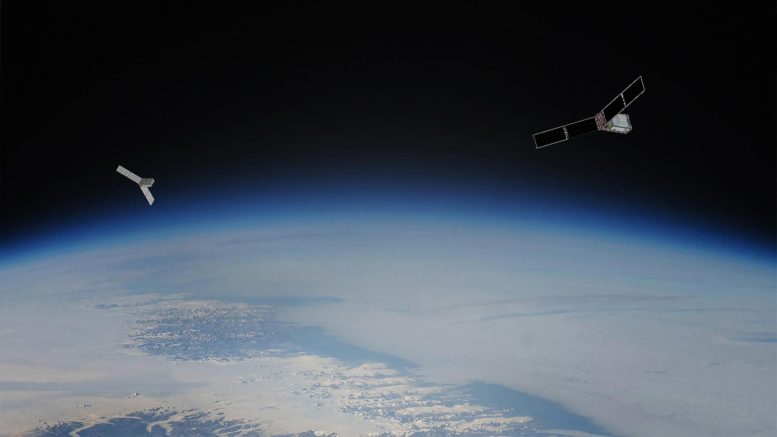This artist’s concept depicts one of the two PREFIRE CubeSats orbiting Earth. The NASA mission will measure the amount of far-infrared radiation emitted into space by the planet’s polar regions — information critical to understanding Earth’s energy balance. Credit: NASA/JPL-Caltech
NASAUsing twin CubeSats, it will measure far-infrared energy emitted by Earth’s polar regions to increase our understanding of how much heat the Earth’s polar regions emit into space and how that affects our climate.
NASA is preparing to send twin shoebox-sized climate satellites to study Earth’s most isolated regions, the Arctic and Antarctica. These satellites are part of a mission designed to measure the heat emitted into space from these polar regions. These important data will improve our understanding of the energy balance between input and output to the Earth, which will significantly affect our knowledge of climate dynamics.
Data collected by the Polar Radiant Energy on Far Infrared Experiment (PREFIRE) mission will deepen our understanding of the greenhouse effect at the poles. It will focus specifically on how water vapor, clouds and other atmospheric components trap heat, preventing it from escaping into space. Researchers will use this data to refine climate and ice models and improve predictions about sea level, weather patterns, and changes in snow and ice as the planet warms.
Each of PREFIRE’s cube satellites, or CubeSats, uses the thermal infrared spectrum to measure heat in the form of far-infrared energy transmitted into space by the Earth’s surface and atmosphere.

The PREFIRE (Polar Radiant Energy in the Far Infrared Experiment) mission will send two cubesats — shown as an artist’s concept against an image of Earth from orbit — into space to study how much heat the planet absorbs and emits from its polar regions. Arctic and Antarctica. Credit: NASA/JPL-Caltech
Here are five things to know about this small but mighty mission:
1. PREFIRE CubeSats will provide new information on how Earth’s atmosphere and ice affect the amount of heat emitted into space from the Arctic and Antarctic.
CubeSats will collect data at the poles using sensors sensitive to infrared wavelengths 10 times higher than any similar instrument. The information gathered by the mission will improve our understanding of when and where the poles transfer heat to space, and why the Arctic has warmed 2½ times faster than the rest of the planet since the 1970s.
2. This mission will focus on the far-infrared region of Earth’s emitted heat into space.
Infrared, a spectrum of long-wavelength light just beyond the visible part of the electromagnetic spectrum, can be perceived as heat. Essentially all of the Earth’s thermal emissions occur in the infrared wavelengths between 4 and 100 micrometers. In the cold polar regions of the planet, 60% of thermal emissions occur at far-infrared wavelengths (above 15 micrometers). Researchers have relatively little data on which parts of the Arctic and Antarctic are experiencing this warming. PREFIRE will help address this lack of knowledge, giving scientists a better idea of how efficiently far-infrared heat is emitted by snow and sea ice, and how clouds affect the amount of far-infrared radiation that escapes into space.
3. Data from PREFIRE will help improve polar and global climate models.
By filling gaps in our knowledge of the Earth’s energy budget, PREFIRE will sharpen our understanding of what is driving the loss of polar ice on land and in the ocean and questions related to sea level rise. This will help researchers better predict how the exchange of heat between Earth and space will change in the future, and how those changes will affect things like ice sheet melting, atmospheric temperatures and global weather. PREFIRE data are available to the public through NASA Atmospheric Science Data Center.
4. PREFIRE CubeSats are designed to answer critical questions using a less expensive platform than a full-scale satellite.
PREFIRE CubeSats use advances in spectrometry to measure processes associated with ice melting and formation, ice melting and accumulation, and changes in cloud cover. A satellite that revisits the same part of the Earth every several days can track seasonal changes that researchers can use to improve climate models. But following interactions between Earth’s surface and atmosphere, the amount of cloud cover temporarily affects the temperature of the area beneath it, requiring frequent measurements. Two satellites in asynchronous near-polar orbits — passing a given location on Earth at different times and viewing the same area within a few hours of each other — can capture some of these short time-scale phenomena.
5. The PREFIRE mission helps train the next generation of satellite climate scientists.
NASA developed PREFIRE with the University of Wisconsin-Madison, including team members from the Universities of Michigan and Colorado. The work engages a diverse group of undergraduate and graduate students who form a significant part of the science team.
NASA’s Jet Propulsion Laboratory manages PREFIRE for the agency’s Science Mission Directorate and provided the spectrometers. Blue Canyon Technologies built the CubeSats and the University of Wisconsin-Madison will process the data the instruments collect. Rocket Lab USA Inc., a launch service provider of Long Beach, California. The rocket lab in New Zealand will launch two prefire cubesats from Launch Complex 1.

„Oddany rozwiązywacz problemów. Przyjazny hipsterom praktykant bekonu. Miłośnik kawy. Nieuleczalny introwertyk. Student.
